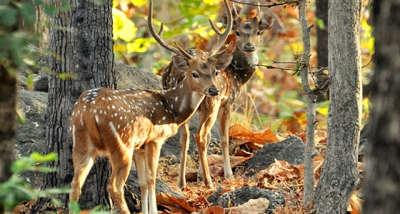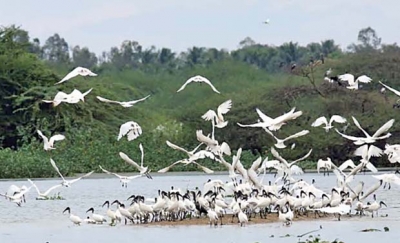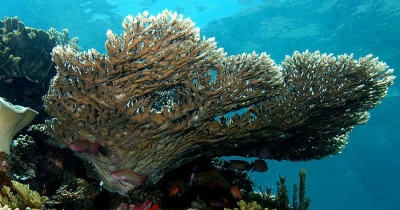Which animals are found in Kanha and Pench national parks?

Part of Project Tiger, both Pench and Kanha are national parks located in Madhya Pradesh. Apart of Pench extends into neighbouring Maharashtra. Together they span over 2,500 sq.km., dominated by moist peninsular sal forests, tropical moist mixed deciduous mixed forest, an abundance of bamboo and trees such as teak and jamun, and green carpets of grassy patches and shrub. The combined regions teem with wildlife – they are a haven for over 1,000 species of plants, animals, and at least 300 species of resident and migrant birds.
Wildlife
A large number of bird species, including ducks, geese, shelducks, pochards, quails, grebes, nightjars, swifts, crakes, storks, herons, ibises, thickknees, plovers, lapwings, jacanas, sandpipers, redshanks, buttonquails, vultures, buzzards, harriers, hornbills, falcons, parakeets, minivets, orioles, cuckooshrikes, pipits, wagtails, buntings, prinias, nuthatches, starlings, flycatchers, thrushes, and wheatears, can be spotted here. Apart from their impressive population of tigers, the regions also nurture leopards, barasingha, mouse deer, barking deer, chital, sambar, bear, black buck, blue bull, chousingha (four-horned antelope), langur, etc.
Kanha: Room for improvement
Considered one of the better managed national parks, Kanha does have a lot of room for improvement. According to a study by the Indian Institute of Forest Management in 2019, one of the areas that need attention is the inadequate number of guards at night, as it opens up potential for poaching. In addition, there appears to be a need for wider and higher use of technology in monitoring the forest areas of the park. It is also said that some regions of the park lack proper fencing, which again unwittingly aids in poaching. It is noted for its work on tigers and the swamp deer species called barasingha. However, there are a lot of other species too that call the forests their home. The study says that other vulnerable species such as black buck and mouse deer need more attention too, and this can be done since the park has the means to do it. Finally, since there are a lot of villagers surrounding the park, human-animal conflicts do occur. Efforts must be taken to resolve this, though usually villagers seem kinder to carnivores attacking their livestock than to herbivores destroying their crops.
Pench: The problem of plenty
In Pench, the very forests that inspired the classic “Jungle Book”, the good news is the bad news. A few years ago, there were reports that pointed to an increase in the tiger population at Pench. While this was heartening news, it also meant that the exact same area (or even less!) will be shared by more number of tigers, animals known for their territorial integrity. This is a problem because the Pench forests are not contiguous with its neighbouring region Kanha where the tigers could move into. In the face of severe space crunch, animals could end up killing each other in territorial fights, stray into human habitation leading to human-animal conflict or the animal could fall into the hands of poachers. Also, the management of Pench is complicated by the fact that it is spread across two States. Each State is said to be functioning differently, though it is just one contiguous forest. Remember, humans create boundaries, not Nature? For instance, when issues such as poaching or human-animal conflict come up, the system to resolve these could be complex due to the issue of boundary and State-based action.
Picture Credit : Google

